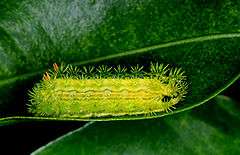Parasa lepida
Parasa lepida, the nettle caterpillar or blue-striped nettle grub, is a moth of the family Limacodidae that was described by Pieter Cramer in 1799. It is a native minor pest found in the Indo-Malayan region, including India, Sri Lanka, Vietnam, Malaysia and Indonesia. It is an introduced pest to urban trees in western Japan.[1][2]
| Blue-striped nettle grub | |
|---|---|
 | |
| Larva | |
.jpg) | |
| Adult | |
| Scientific classification | |
| Kingdom: | |
| Phylum: | |
| Class: | |
| Order: | |
| Family: | |
| Genus: | |
| Species: | P. lepida |
| Binomial name | |
| Parasa lepida (Cramer, 1799) | |
| Synonyms | |
| |
Description
In the male, the head is greenish, with red brown at the sides. The thorax is green with a brown stripe on the vertex. Abdomen brown. Forewings are pale green, resembling the colour of a pea plant. There is a red-brown basal patch on the costa. Outer area is reddish brown, widest at inner margin. Hindwing yellowish at base, reddish brown towards margin. Legs have pale tipped joints. In the female, the reddish-brown stripe on the thorax is much wider and nearly the whole of the hindwing is reddish brown. Larva pale green, whitish or bright yellowish green on the dorsal surface. There are three green bands throughout the body. Sub-dorsal and sub-lateral series of short spinous tubercles, the spines of the anterior and posterior tubercles tipped with red. Cocoon purple brown. Eggs are flat and overlap each other. Eggs are covered by a transparent cement.[3]
Ecology
The egg stage lasted six days, the larval stage forty days and the pupal stage twenty-two days, may fluctuate with climatic changes.[4] The larvae are considered pests and have been recorded from commercial crops[5] like coffee, rubber, oil palm, cocoa, cassava, tea, ebony, coconut, gliricidia, banana, winged bean and mango.[6] The female is known to emit pheromone (Z)-7,9-Decadien-1-ol as a semiochemical.[7]
The cuckoo wasp, Chrysis shanghaiensis is a known parasite on the caterpillars.[8] In August 1986, dead larvae were found on coconut leaves from India. Experiments showed that, multiple embedded baculovirus is the causative agent for the disease.[9]
References
- "Ecology of the Blue-Striped Grub Moth Parasa lepida (Lepidoptera: Limacodidae) in Japan". Nova Science Publishers. pp. 187–202. Retrieved 18 July 2016.
- Yamazaki, Kazuo; Kitamoto, Toshio; Yariyama, Yoriko; Sugiura, Shinji (2007). "An analysis of spatial distribution in the exotic slug caterpillar Parasa lepida (Cramer) (Lepidoptera: Limacodidae) at an urban coastal site in central Japan". The Pan-Pacific Entomologist. 83 (3): 193–199. doi:10.3956/0031-0603-83.3.193.
- Hampson, G. F. (1892). The Fauna of British India, Including Ceylon and Burma: Moths Volume I. Moths - Vol. I. Taylor and Francis – via Biodiversity Heritage Library.
- "Latoia (Parasa) lepida (Cramer) Lepidoptera Limacodidae, a coconut pest in Indonesia". CABI. 1982. Retrieved 18 July 2016.
- "Parasa lepida (Cramer)". ICAR-National Bureau of Agricultural Insect Resources. Retrieved 18 July 2016.
- "Nettle caterpillar (Parasa lepida)". Plantwise Technical Factsheet. Retrieved 18 July 2016.
- "Semiochemicals of Parasa lepida, the Blue-striped nettle grub". The Pherobase: Database of Insect Pheromones and Semiochemicals. Retrieved 18 July 2016.
- Sevastopulo, D. G. (2009). "Chrysis shanghaiensis Smith, a Parasite of Parasa lepida Cr". Proceedings of the Royal Entomological Society of London A. 12: 11. doi:10.1111/j.1365-3032.1937.tb00908.x.
- Philip, Babu M.; Paul, Sheela; Joseph, T.; Joseph, D. (1988). "A multiple embedding virus of Parasa lepida (Cramer) (Limacodidae: Lepidoptera) in India". Tropical Pest Management. 34 (1): 107–108. doi:10.1080/09670878809371221.